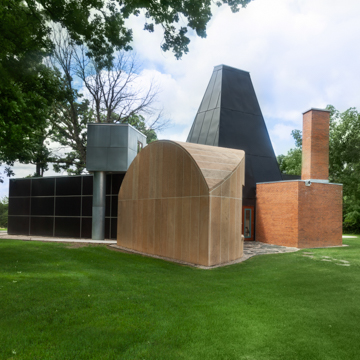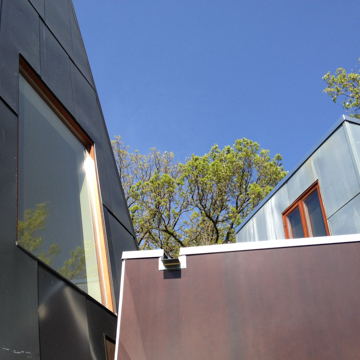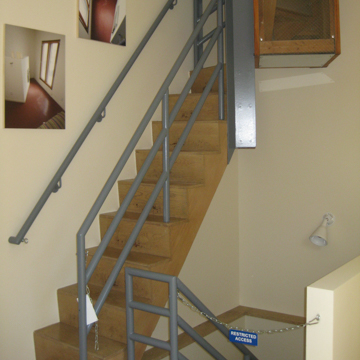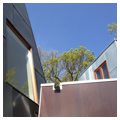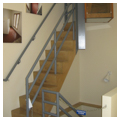In 1982, Mike and Penny Winton hired architect Frank Gehry to design a guest house for their grandchildren on the Lake Minnetonka property also occupied by a Philip Johnson house from the 1950s. Undeterred by proximity to an exemplar of Johnson’s mid-century modernism, Gehry positioned elemental forms in a variety of materials, showcasing his own unique brand of groundbreaking and playful architecture. Upon its 1987 completion, the Winton Guest House was recognized as one of his most notable projects to date, a composition in which architecture is intentionally conceptualized as art. Indeed, from certain vantage points without view of windows or doors, the house appears as a freestanding sculpture, accentuating the surrounding landscape.
The Winton Guest House comprises six disparate elements unified by their pin-wheeling effect off a central living room space. Although visually complex, the forms are conventional in their geometry as compared with the digitally derived elements of Gehry’s more recent work. While early discussions suggested the possibility of covering the entire building in zinc, in the end the architect gave each element of the composition a material identity as distinct as its form. The forms stand on their own as each piece barely touches another, and they remain pure, as no exterior joints, hardware, or utility boxes are visible.
The 35-foot-tall, pyramidal living room is finished with black painted metal (as is the shed-roofed bedroom). Windows of various shapes and sizes and a skylight allow natural light into the living room. The simple porcelain fixtures with their exposed bulbs provide a great play of light on the tower walls at night. A cubical fireplace room is faced with the same color brick as the Johnson house (coppertone smooth modular), and a rectangular-shaped garage/kitchenette is covered in a graphically patterned mixture of Finnish plywood (Finn-ply) and aluminum strips. Gehry placed the garage adjacent to the kitchen so the two spaces could function together as a part-time potting shed and vehicle storage for a car and tractor. The garage was accessible by a roll-up door on the short end and a sliding barn-like door near the kitchen entrance.
The curving form of the stone bedroom consists of a steel frame filled with fiberglass insulation overlaid by a 2 x 6-inch plywood batten framework covered with a waterproof membrane both over and under the battens. Clips mounted on the battens hold the dolomitic limestone, quarried from the Vetter Stone Quarry near Mankato, Minnesota. The stone cuts were difficult and their sizes varied; on the floors stone pieces measure 2 x 2 feet, but on the elevations they range between 18 and 24 inches wide and up to almost 8 feet tall.
In early designs for the house, Gehry included the form of a log cabin as a more complex second story of the house. Over time these shapes gave way to a single rectilinear, galvanized sheet metal loft over the garage. Although built largely for the grandchildren’s enjoyment, the loft also fulfilled Gehry’s desire “that this building…have a certain amount of humor and mystery and fantasy, so that visiting children will remember their trip to grandma’s house.” The staircase, with its exposed construction recalling Gehry’s residence in Santa Monica, was a favorite design element of the clients and the architect himself.
Many consider the Winton Guest House to be a turning point in Gehry’s career. After this project, he moved out of the domestic realm and completed more public commissions than in previous years. And beginning with the early 1990s design for the Weisman Art Museum on the University of Minnesota’s Minneapolis campus, and then with the 1997 Guggenheim Museum in Bilbao, Spain, his work unified the disparate materials found in the guest house, cladding them with one material as he created space that constantly challenged architectural norms.
Due to its original design, the Winton Guest House attracted attention almost immediately, garnering national and international recognition for Gehry’s refreshing architectural style. In 1987 the completed house won the first House and Garden magazine Design Award for Architecture and an Award of Honor from the Los Angeles Chapter of the American Institute of Architects. Time magazine included the house in its “Best of ‘87” design section. The national chapter of the American Institute of Architects also recognized the importance of Gehry’s design with a 1988 Honor Award, given to elevate the general quality of architecture, establish a standard of excellence, and inform the public of the value of architectural practice.
The house was gifted to the University of St. Thomas in 2007, which initiated the long process of dismantling the building, moving it piece by piece 110 miles, and reconstructing it at the university’s Gainey Campus in Owatonna, Minnesota. The Winton Guest House reopened in 2011 as a museum dedicated to Frank Gehry and the house itself.
In the summer of 2014, St. Thomas sold its Gainey Campus, with a provision that allowed the university to find a buyer for the Guest House who was willing to move it from the Owatonna site. It went up for auction in the summer of 2015 and was purchased by private buyers who disassembled and relocated it late in 2016 to an undisclosed location in the Hudson River Valley of New York State.
References
Friedman, Mildred. Frank Gehry: The Houses. New York: Rizzoli, 2009.
Young, Victoria M., curator. The House as Art. Exhibition shown at the Winton Guest House, Owatonna, Minnesota, 2011–2014.






